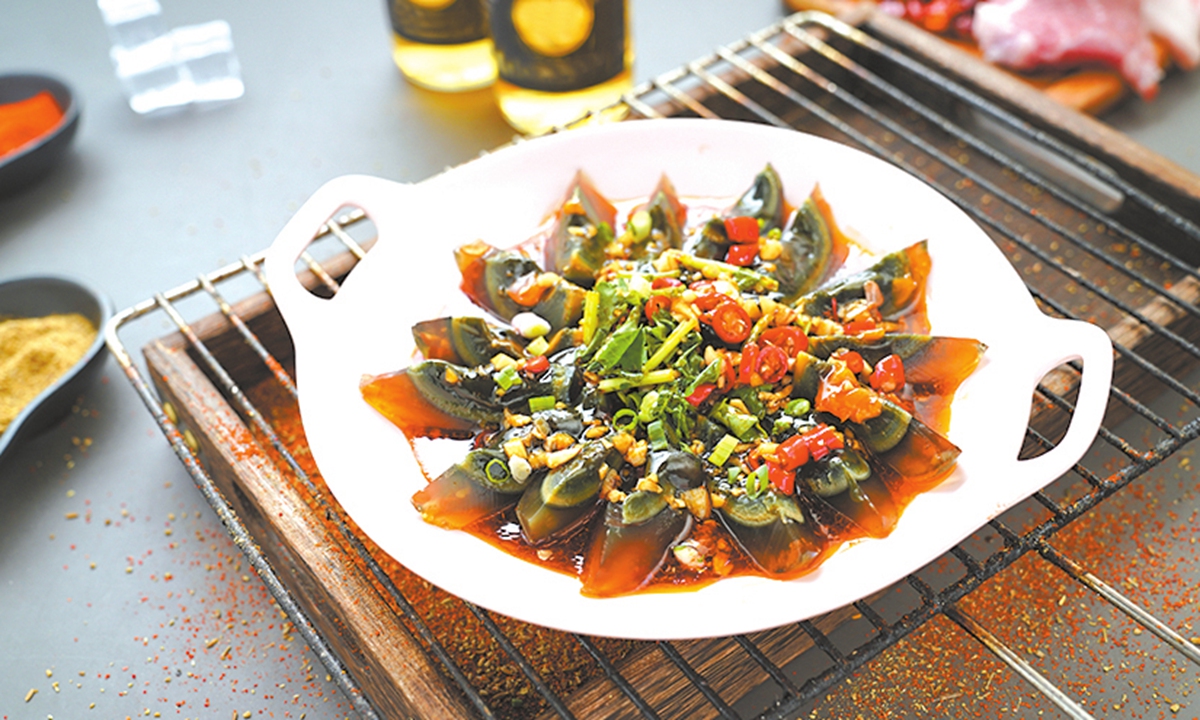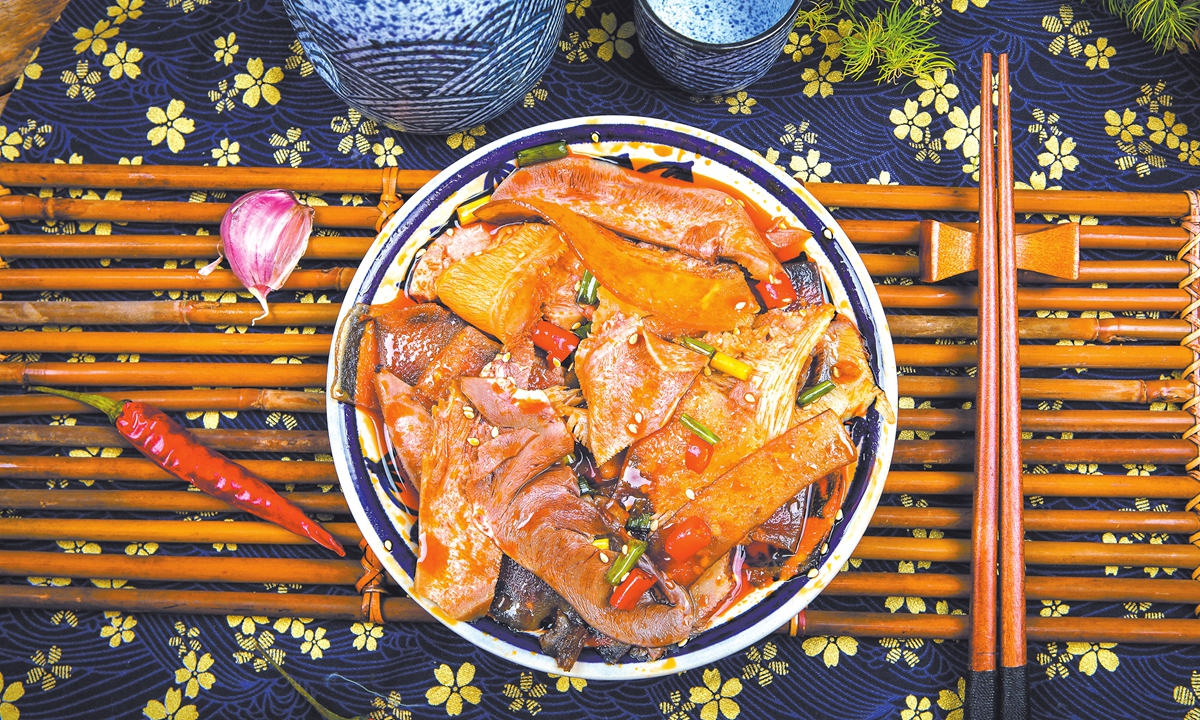When it comes to Chinese cuisine, a large number of dishes are celebrated as delicacies, but a few are often regarded as "weird" by foreigners who have never tried.

The century egg, or pidan Photos: VCG
Among the most typical examples is the century egg, or pidan in Chinese. In 2018, the Disgusting Food Museum in Malmö, Sweden, surprisingly featured century eggs in its exhibit of the world's most "disgusting" foods.
But why are foods like century eggs, chicken feet, and animal offal, which are everyday delicacies in China, considered unpalatable by foreigners?
The answer lies in cultural differences and varying dietary preferences.
Traditionally, in China, a signifi cant cultural value is placed on the appreciation for diverse and unique flavors. However, many foreigners are unfamiliar with many of the foods on offer in China and hold different taste preferences.
But in recent years, an increasing number of foreign visitors and gourmets have initiated to try the new tastes they couldn't find easily in their home country.

Mao xue wang
A timeless delicacy
Century eggs, also known as preserved eggs, are a beloved staple in Chinese cuisine with a history spanning centuries. It is said that during the Ming Dynasty (1368-1644) period, the owner of a tea house accidentally discovered that duck eggs buried in ash mixed with tea leaves had a unique aroma and a fresh, smooth texture.
Later, not only duck eggs but also chicken eggs, goose eggs, and others started being made into century eggs. Typically, century eggs made from chicken eggs are yellow and translucent, while those made from duck eggs are dark green and more common.
Although pidan is referred to as a century egg or even a "thousand-year egg" in English, it doesn't actually take that long to make. The process typically takes just a few days or up to about a month.
Made through a traditional process of curing fresh eggs in a mixture of clay, ash, salt, quicklime, and rice hulls, the eggs undergo a chemical transformation that turns the egg white into a dark, translucent jelly and the yolk into a creamy paste.
The distinctive appearance and intense aroma of century eggs are cherished in China. The eggs are often served in porridge, as a cold appetizer, or even as a topping for other dishes. In some regions, it is also enjoyed on its own.
On Douyin, the Chinese version of TikTok, some videos show foreigners reacting to pidan, and many seem to dislike it.
Despite its divisive reputation, century eggs continue to attract curious eaters from all over the world. In June 2024, KFC China even launched a century egg tart, blending traditional flavors with modern fast food.

Fuqi feipian, a spicy Sichuan dish
A gastronomic icon
Another Chinese delicacy that baffles many Westerners is chicken feet, or feng zhao. Commonly served as a snack or in dim sum, chicken feet can be marinated, fried, steamed or boiled, resulting in a chewy texture.
At night markets all over China, chicken feet are usually an essential delicacy, while in Guangdong Province and other areas of southern China, chicken feet are also served as a breakfast item.
Sometimes the bones are specifically removed from chicken feet to make them easier to eat.
According to data from iiMedia Research, the online market for boneless chicken feet in China reached 4.98 billion yuan ($698.3 million) in 2023, and the market is projected to grow to 7.76 billion yuan by 2028, with the vast majority of consumers belonging to the younger generations, buyers under 44 years old account for 93.59% of the market.
Despite their popularity in China, chicken feet face significant resistance in Western countries due to health concerns, their appearance, and the unfamiliar eating experience.
Two American students visiting East China's Jiangsu Province earlier this month told the Global Times that they tried the chicken feet during their travel, describing them as "surprisingly good," and admitting that they "really liked them."
A culinary feast
Beyond century eggs and chicken feet, Chinese cuisine also embraces a wide range of animal offal, including organs like liver, kidney, and intestines. Dishes like luzhu in Beijing, made from pork head meat and pork offal, and fuqi feipian, a spicy Sichuan dish made from beef heart, tongue, and tripe, showcase the Chinese penchant for using every part of the animal.
Additionally, many parts of China use pork intestines to make Chinese sausage and in the southwestern regions, particularly in Sichuan and Chongqing, intestines are a key ingredient in many spicy dishes.
Mao xue wang, a famous Sichuan dish, features duck blood, beef tripe, and pork intestines cooked in a numbing and spicy broth made with Sichuan peppercorns and chili peppers. Another popular dish is a noodle dish topped with stir-fried pig intestines and tofu, known for its bold flavors and chewy texture.
In addition to animal offal, traditional Chinese cuisine offers other examples of strong-flavored delicacies, one of the most well-known being stinky tofu. As the name suggests, stinky tofu is known for its pungent odor, which results from the fermentation process. While the smell can be off-putting, the flavor is beloved by many Chinese diners.
As global food cultures increasingly blend, an interest in traditional Chinese dishes is also growing. While some may never fully embrace century eggs or stinky tofu, a rising number of adventurous eaters are challenging their palates to experience the rich diversity of Chinese cuisine.



